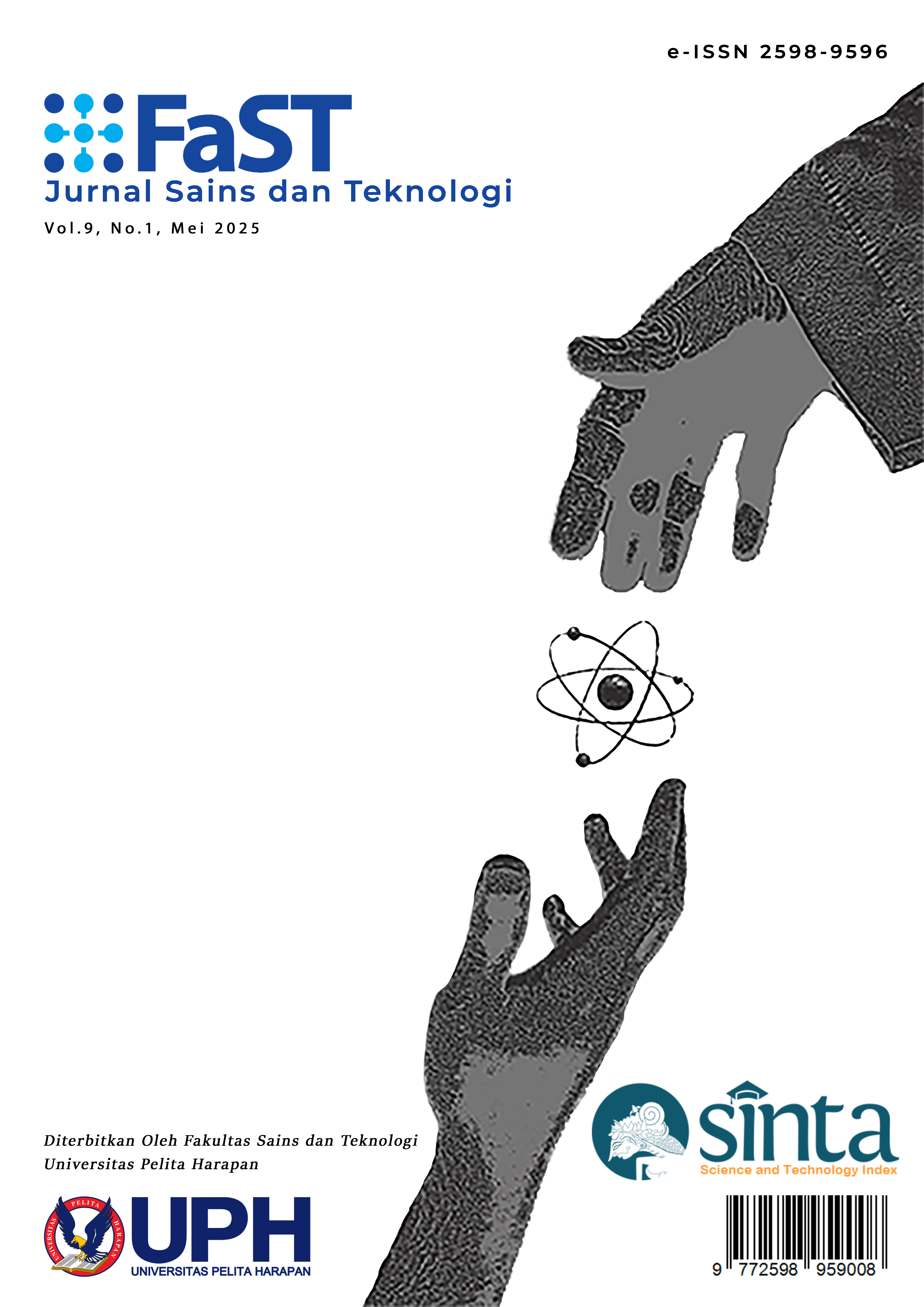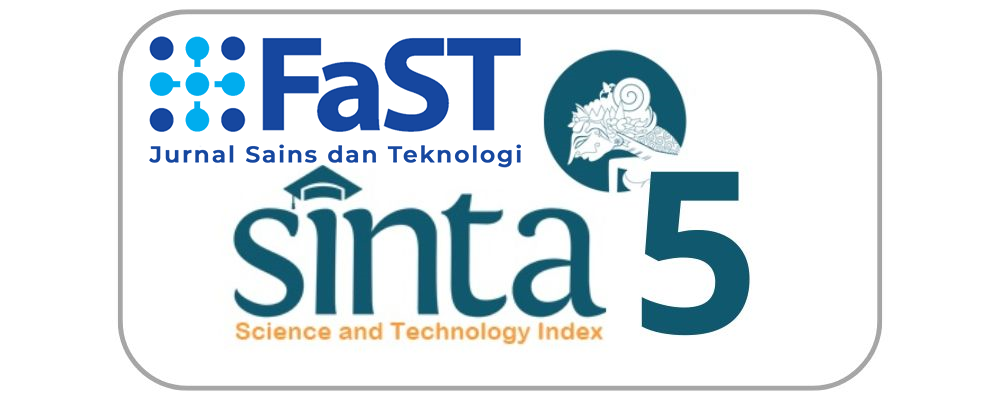Pemanfaatan Kolagen Limbah Ikan Tuna dalam Meningkatkan Pertumbuhan Bacillus Subtilis sebagai Kandidat Probiotik
[Utilization of Collagen From Tuna Fish Waste to Enhance The Growth of Bacillus Subtilis as A Probiotic Candidate]
DOI:
https://doi.org/10.19166/jstfast.v9i1.9730Keywords:
Bacillus subtilis, probiotik, limbah ikan tuna, hidrolisat kolagen, pertumbuhanAbstract
Probiotics are a group of bacteria with health benefits, which are widely used in various nutritional products. Various efforts are made to effectively increase growth of probiotics, including adding supplemental nutrition, such as protein. In this study, a series of tests were conducted (optical density, colony forming unit, and pH test) to evaluate the effect of collagen hydrolysate supplementation, obtained from tuna waste, on the growth of Bacillus subtilis G8, a candidate of probiotic bacteria which have been isolated from the Japanese traditional food natto. The results demonstrated positive impacts of collagen hydrolysate supplementation on cell density and colony-forming units, as well as on the reduction of pH of bacterial growth medium. Concentration of 5% was observed as the most optimum concentration to support the bacterial growth, while the most acidic pH of bacterial growth medium is observed at 3% supplementation. In conclusion, supplementation of collagen hydrolysate derived from tuna waste supported the growth of B. subtilis G8 as well as reduced the pH of its growth media.
Bahasa Indonesia Abstract: Probiotik merupakan sekelompok bakteri yang memiliki manfaat kesehatan dan banyak digunakan dalam berbagai produk nutrisi. Beragam upaya telah dilakukan untuk secara efektif meningkatkan pertumbuhan probiotik, salah satunya melalui penambahan nutrisi tambahan seperti protein. Dalam penelitian ini, serangkaian uji dilakukan, meliputi uji kerapatan optik, unit pembentuk koloni (CFU), dan pengukuran pH, untuk mengevaluasi pengaruh suplementasi kolagen hidrolisat yang diperoleh dari limbah ikan tuna terhadap pertumbuhan Bacillus subtilis G8, yakni kandidat bakteri probiotik yang diisolasi dari makanan tradisional Jepang, natto. Hasil penelitian menunjukkan bahwa suplementasi kolagen hidrolisat memberikan dampak positif terhadap kerapatan sel dan jumlah koloni, serta menyebabkan penurunan pH medium pertumbuhan bakteri. Konsentrasi 5% diketahui sebagai konsentrasi yang paling optimal dalam mendukung pertumbuhan bakteri, sedangkan pH terendah pada medium pertumbuhan tercatat pada konsentrasi suplementasi sebesar 3%. Dengan demikian, dapat disimpulkan bahwa suplementasi kolagen hidrolisat yang berasal dari limbah ikan tuna mampu mendukung pertumbuhan B. subtilis G8 serta menurunkan pH media pertumbuhannya.
References
Avila-Rodríguez, M. I., Rodríguez-Barroso, L. G., & Sánchez, M. L. (2017). Collagen: A review on its sources and potential cosmetic applications. Journal of Cosmetic Dermatology, 17(1), 20–26. https://doi.org/10.1111/jocd.12450
Baek, G. H., Yoo, K. M., Kim, S. Y., Lee, D. H., Chung, H. Y., Jung, S. C., Park, S. K., & Kim, J. S. (2023). Collagen peptide exerts an anti-obesity effect by influencing the Firmicutes/Bacteroidetes ratio in the gut. Nutrients, 15, 2610. https://doi.org/10.3390/nu15112610
Bianchi, F. M., Angelinetta, C., Rizzi, G., Praticò, A., & Villa, R. (2022). Evaluation of the efficacy of a hydrolyzed collagen supplement for improving skin moisturization, smoothness, and wrinkles. The Journal of Clinical and Aesthetic Dermatology, 15(3), 48–52.
Binda, S., Hill, C., Johansen, E., Obis, D., Pot, B., Sanders, M. E., Tremblay, A., & Ouwehand, A. C. (2020). Criteria to qualify microorganisms as "probiotic" in foods and dietary supplements. Frontiers in Microbiology, 11, Article 1662. https://doi.org/10.3389/fmicb.2020.01662
Dikson, D., Victor, H., Jong, D., Sanjaya, A., Samantha, A., Jo, J., & Pinontoan, R. (2022). Whole-genome analysis of Bacillus subtilis G8 isolated from natto. Biodiversitas Journal of Biological Diversity, 23(3). https://doi.org/10.13057/biodiv/d230313
Dinas Lingkungan Hidup Kabupaten Buleleng. (2022). Pengasaman laut serta dampaknya terhadap ekosistem laut. Pemerintah Kabupaten Buleleng. https://dlh.bulelengkab.go.id/informasi/detail/artikel/85_pengasaman-laut-serta-dampaknya-terhadap-ekosistem-laut
Edwards, T. M., Puglis, H. J., Kent, D. B., Durán, J. L., Bradshaw, L. M., & Farag, A. M. (2024). Ammonia and aquatic ecosystems: A review of global sources, biogeochemical cycling, and effects on fish. Science of The Total Environment, 907, 167911. https://doi.org/10.1016/j.scitotenv.2023.167911
Elshaghabee, F. M. F., Rokana, N., Gulhane, R. D., Sharma, C., & Panwar, H. (2017). Bacillus as potential probiotics: Status, concerns, and future perspectives. Frontiers in Microbiology, 8, Article 1490. https://doi.org/10.3389/fmicb.2017.01490
Foucher, C. D., & Tubben, R. E. (2023). Lactic acidosis. StatPearls Publishing. https://www.ncbi.nlm.nih.gov/books/NBK470202/
Fritze, D., & Claus, D. (1995). Spore-forming, lactic acid producing bacteria of the genera Bacillus and Sporolactobacillus. In B. J. B. Wood & W. H. Holzapfel (Eds.), The genera of lactic acid bacteria: The lactic acid bacteria (Vol. 2, pp. 359–370). Springer. https://doi.org/10.1007/978-1-4615-5817-0_11
Fusco, W., Lorenzo, M. B., Cintoni, M., Porcari, S., Rinninella, E., Kaitsas, F., ... & Ianiro, G. (2023). Short-chain fatty-acid-producing bacteria: Key components of the human gut microbiota. Nutrients, 15(9), 2211. https://doi.org/10.3390/nu15092211
Gauza-Włodarczyk, M., Kubisz, L., & Włodarczyk, D. (2017). Amino acid composition in determination of collagen origin and assessment of physical factors effects. International Journal of Biological Macromolecules, 104(Pt A), 987–991. https://doi.org/10.1016/j.ijbiomac.2017.07.013
Geahchan, S., Baharlouei, P., & Rahman, A. (2022). Marine collagen: A promising biomaterial for wound healing, skin anti-aging, and bone regeneration. Marine Drugs, 20(1), 61–77. https://doi.org/10.3390/md20010061
Hazan, R., Que, Y. A., Maura, D., & Rahme, L. G. (2012). A method for high-throughput determination of viable bacterial cell counts in 96-well plates. BMC Microbiology, 12, Article 259. https://doi.org/10.1186/1471-2180-12-259
Kementerian Kelautan dan Perikanan. (2024). Hari Tuna Sedunia, KKP akan tingkatkan kualitas dan jangkauan pasar tuna Indonesia. https://kkp.go.id/news/news-detail/hari-tuna-sedunia-kkp-akan-tingkatkan-kualitas-dan-jangkauan-pasar-tuna-indonesia.html
Kumar, R., & Pundir, S. (2021). Bacterial cell, classification and required essential contents for growth. Asian Journal of Pharmacy and Technology, 11(2), 181–187. https://doi.org/10.52711/2231-5713.2021.00030
Leñini, C., Rodriguez, A. F., Goñi, A. J., Rateni, L., Nakamura, A., & Grau, R. R. (2023). Probiotic properties of Bacillus subtilis DG101 isolated from the traditional Japanese fermented food nattō. Frontiers in Microbiology, 14, Article 1253480. https://doi.org/10.3389/fmicb.2023.1253480
Lucy, J., Raharjo, P. F., Elvina, Florencia, L., Susanti, A. I., & Pinontoan, R. (2019). Clot lysis activity of Bacillus subtilis G8 isolated from Japanese fermented natto soybeans. Applied in Food Biotechnology, 6, 101–109. https://doi.org/10.22037/afb.v6i2.22479
Mei, F. F., Duan, Z. W., Chen, M. X., Lu, J. F., Zhao, M. H., Li, L. H., Shen, X. R., Xia, G. H., & Chen, S. J. (2020). Effect of a high-collagen peptide diet on the gut microbiota and short-chain fatty acid metabolism. Journal of Functional Foods, 75(3), Article 104278. https://doi.org/10.1016/j.jff.2020.104278
Mohamadzadeh, M., & Abbaspour, S. (2024). Probiotic applications of Bacillus subtilis. In H. Razafindralambo (Ed.), Bacillus subtilis – Functionalities and emerging applications (pp. xx–xx). IntechOpen. https://doi.org/10.5772/intechopen.1007134
Moreno-Pérez, D., Bressa, C., Bailén, M., Hamed-Bousdar, S., Naclerio, F., Carmona, M., Pérez, M., González-Soltero, R., Montalvo-Lominchar, M. G., Carabaña, C., & Larrosa, M. (2018). Effect of a protein supplement on the gut microbiota of endurance athletes: A randomized, controlled, double-blind pilot study. Nutrients, 10, 337. https://doi.org/10.3390/nu10030337
Najoan, M. (2019). Limbah ikan sebagai pakan ternak. Fakultas Ilmu Budaya UNSRAT. https://repo.unsrat.ac.id/4981/1/3.%20Limbah%20Ikan%20Sebagai%20pakan%20Ternak%20%28sebagai%20Editor%29.pdf
Pantazi, A. C., Balasa, A. L., Mihai, C. M., Chisnoiu, T., Lupu, V. V., Kassim, M. A. K., ... & Cambrea, S. C. (2023). Development of gut microbiota in the first 1000 days after birth and potential interventions. Nutrients, 15(16), 3647. https://doi.org/10.3390/nu15163647
Pinontoan, R., Elvina, Sanjaya, A., & Jo, J. (2021). Fibrinolytic characteristics of Bacillus subtilis G8 isolated from natto. Bioscience of Microbiota, Food and Health, 40(3), 144–149. https://doi.org/10.12938/bmfh.2020-071
Setiani, B. E., Pramono, Y. B., & Purwitasari, L. (2019). Review on pathogenic bacteria Listeria monocytogenes, the detection and the sequencing gene methods isolated from meat products. Journal of Applied Food Technology, 6(2), 44–51. https://doi.org/10.17728/jaft.6460
Szopa, K., Znamirowska-Piotrowska, A., Szajnar, K., & Pawlos, M. (2022). Effect of collagen types, bacterial strains, and storage duration on the quality of probiotic fermented sheep's milk. Molecules, 27(9), Article 3028. https://doi.org/10.3390/molecules27093028
World Health Organization Expert Consultation. (2001). Evaluation of health and nutritional properties of powder milk and live lactic acid bacteria. Food and Agriculture Organization of the United Nations and World Health Organization. https://openknowledge.fao.org/handle/20.500.14283/y63
Downloads
Published
Issue
Section
License
Copyright (c) 2025 Suawa Natania Abigail Christy, Accoladea Wijaya, Angela Clarita Putri, Jennifer Claudia Suryadi, Cecilia Aileen Yap, Chelsea Valeria Simamora, Jennifer Patricia Tjhajadi, Celeste Abigail Thanos, Gisella Theodora, Michella Irawan, Veronica Tammy Soputro, Adrian Samuel Thenoch, Reinhard Pinontoan, Juandy Jo

This work is licensed under a Creative Commons Attribution-ShareAlike 4.0 International License.
“Authors who publish with this journal agree to the following terms:
1) Authors retain copyright and grant the journal right of first publication with the work simultaneously licensed under a Creative Commons Attribution License (CC-BY-SA 4.0) that allows others to share the work with an acknowledgement of the work's authorship and initial publication in this journal.
2) Authors are able to enter into separate, additional contractual arrangements for the non-exclusive distribution of the journal's published version of the work (e.g., post it to an institutional repository or publish it in a book), with an acknowledgement of its initial publication in this journal.
3) Authors are permitted and encouraged to post their work online (e.g., in institutional repositories or on their website). The final published PDF should be used and bibliographic details that credit the publication in this journal should be included.”



